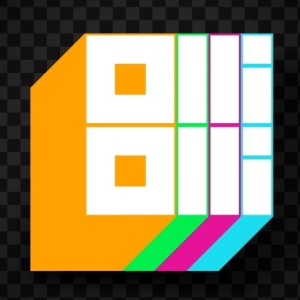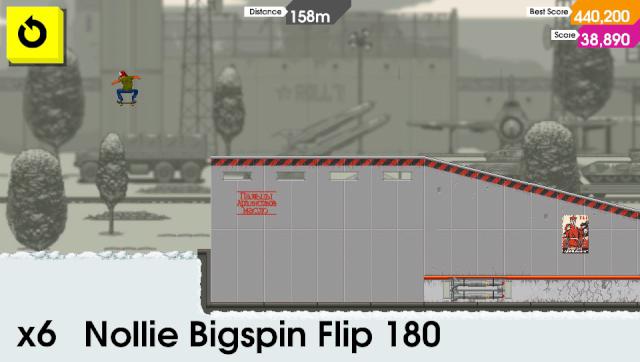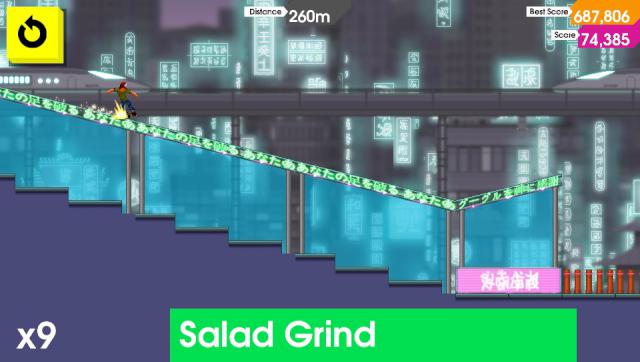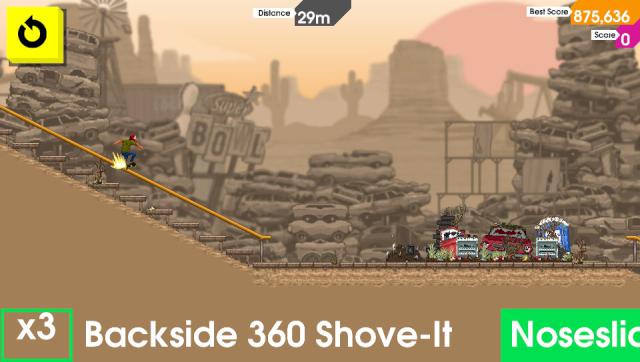
When I see kids skateboarding on the park, practising a simple kickflip and bailing, I have to resist the urge to laugh. I’ve played Tony Hawk. I’ve pulled off 1080s, Christ Airs, I’ve ollied and nollied like a pro. But after playing OlliOlli on the Vita, I have a new found respect for them.
If you have fond memories of Tony Hawk skateboarding games over the last fifteen years, you are going to find your first session with OlliOlli maddeningly infuriating.
In essence, Olli Olli is a retro styled 2D skateboard game, but it is almost as un-Tony-Hawk-like as a skating game can be. It’s a Vita exclusive, from first time developers Roll7. It looks cute, it looks a lot like those relatively simple ‘endless runner’ games so prevalent on smart phones although don’t let that fool you – Olli Olli relies on it’s finely honed control system, which is quite unlike other skating games you may have tried.

The problem is, at least initially, that 15 years of skateboarding games leave you with the muscle memory that you press Cross to jump, Triangle to grind, and, well, as long as you are positioned right, you’ll land just fine.
Olli Olli turns all of that on its head. See, like real skating, Olli Olli understands that all the fancy flips and kicks you can pull off are utterly worthless if you cannot land them. The control system appears at first to be very basic, pull the left stick to choose your trick, release it to actually perform it, then press X to land. Simple enough, no?
Before long, the tutorial introduces you to the variety of tricks that the seemingly simple control method allows you to pull off. You see, your tricks only perform once the stick is released to its neutral position, which allows you all sorts of rotational variation. Push left, rotate clockwise three quarters, THEN release, for example.
Also, timing of your pressing the X button to land your trick is also essential – hit it too late, and you will bail – and that will be the end of your run (luckily, restarting the level is only a screen tap away). Press it too early, and your landing may be sloppy, or sketchy and will result in a single digit score for your entire combo run. But hit it at just the right moment, just before you land, and your trick will highlight in green, giving you bonus points, and a slight speed boost as well.
Soon the game introduces grindable surfaces, such as railings, market stalls and cranes. To start a grind, you use your left stick again, with the direction you push determining the grind. Just like landing a trick, though, the timing is key – hit it just right for a speed boost and a higher score.

Next, you are shown how the L and R triggers can be used to spin while in the air, giving you yet more opportunities to increase your score.
For a short while, the game feels like patting your head and rubbing your stomach – you’ll find yourself trying to grind instead of land, land instead of spin, spin instead of grind, or slip back into forgetting to land at all. You will bail. Repeatedly. Painfully. You will feel like shouting and swearing at the screen, but that big yellow restart button will call out to you, just one more go, just one more go, I’ll do it this time.
The game is structured around different zones, containing 5 levels, each of which will have 5 objectives, such as score a 30,000 combo, score 90,000 points, collect 5 icons from grinding surfaces. In addition to this, reaching the finish line will unlock the Pro version of that level – cunningly designed to be completed as one long combo – as long as your fingers are up to the task.

On top of this there are Spots which are short levels for you to pull off a single combo – as soon as you land the run is over. Oddly this doesn’t have any friend leaderboards, something that would really bring this into its own. While some people love competing to be in use world top ten, I don’t need reminding just how many tens of thousands of people are better than me, I find it far more satisfying to compete against my friends.
The final mode in the game is the perfectly named Daily Grind. This gives you a new level every day, that you practise on as much as you like. But once you are ready to play it for real, you only get one chance. Bail and post a pitiful score, and that’s literally game over, no second chances, come back tomorrow.
So in summary, we have what appears to be a bundle of negatives – a control system you will struggle to adapt to, an unforgiving gameplay mechanism, an archaic graphical style, a game you are destined to fail at over and over again. Yet somehow Olli Olli just works. It has that perfect element of “just one more go” (aided by a super fast restart system, meaning a fresh run is only a screen tap away). The controls, while initially counterintuitive, are incredibly tight, and the retro graphics add a level of charm to the whole affair. In fact the only genuine negatives I can think of, are the lack of friend leaderboards, something Roll7 claim is on it’s way. Last but not least, the game is only £7.99 so has the TGR seal of approval – it is a solid addition to the fine library of indie games that the Vita has been building of late, and deserves a spot on your memory card.
Oh, and next time you see some kids down the park bailing after pulling off a simple kickflip? Remember Olli Olli, and give them a nod of respect.
Reviewed on Playstation Vita


Leave a Reply